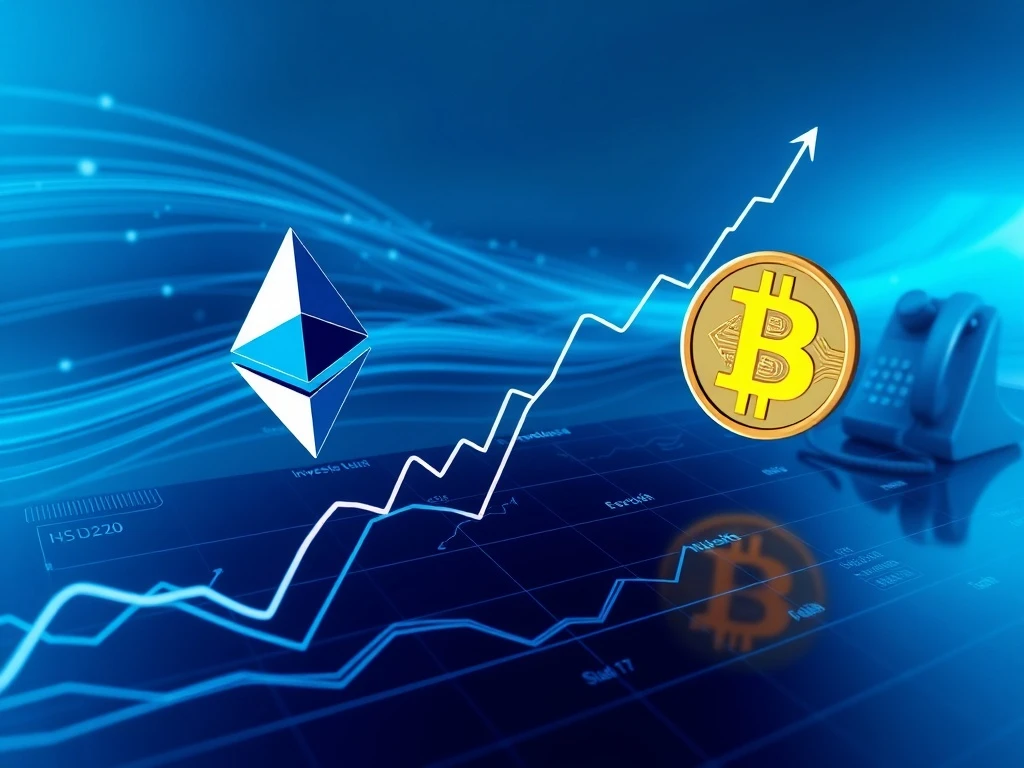Explosive Claims: Ether Machine Founder Sparks Controversial ETH vs BTC Performance Debate

In the ever-evolving world of digital assets, bold claims often ignite passionate discussions. Andrew Keys, co-founder of the newly formed Ethereum investment firm The Ether Machine, recently made waves with a controversial assertion: investors would have seen significantly greater returns with Ethereum (ETH) than Bitcoin (BTC) over the past decade. This declaration, made during a CNBC appearance, positions Keys as an unapologetic “Ethereum maxi,” drawing a stark analogy between Bitcoin and a “landline” while likening Ethereum to an “iPhone.” But how does this claim stand up to scrutiny, and what does it mean for the future of crypto investment?
Unveiling The Ether Machine: A New Era for Ethereum Investment
Andrew Keys’ statements coincide with the highly anticipated launch of The Ether Machine, a new investment vehicle poised to make a significant impact on the institutional crypto landscape. Keys, serving as the firm’s chairman, announced plans for a public listing on Nasdaq. This strategic move aims to provide the largest public vehicle for institutional Ethereum exposure, with an initial treasury boasting over 400,000 ETH, valued at approximately $1.5 billion. This substantial holding is set to eclipse existing Ethereum treasuries from firms like Bitmine and SharpLink, signaling a growing appetite among institutional players for direct access to Ethereum.
The firm’s launch, facilitated through a merger with the blank-check company Dynamix Corporation, underscores a broader trend of traditional finance embracing digital assets. The Ether Machine’s mission is clear: to become a dominant force in the Ethereum ecosystem, providing a streamlined pathway for large-scale investors to gain exposure to the network’s potential. This development alone is a testament to Ethereum’s maturation and its increasing recognition as a foundational layer of the decentralized economy.
The ETH vs BTC Performance Debate: A Deeper Dive
Keys’ core argument hinges on the notion that “the price of Ether per Bitcoin over the past decade has materially improved.” He initially claimed a 50x return advantage for Ethereum, later correcting it to 30x. While these figures might seem staggering, a closer look at the historical data reveals a more nuanced picture regarding ETH vs BTC performance.
- Bitcoin’s Early Days: Bitcoin (BTC) entered the scene much earlier, with its genesis in 2009. Its earliest recorded value, during the infamous Pizza Day in May 2010, was a mere $0.0041. When it first traded on exchanges like Mt. Gox in July 2010, its price was around $0.05. Since then, Bitcoin has delivered a staggering gain of over 234 million percent.
- Ethereum’s Genesis: Ethereum (ETH) emerged significantly later, with its genesis block in July 2015. At this point, Bitcoin was already trading around $280. Ether’s average price in its inaugural month was approximately $1.60. From that starting point, Ethereum has indeed seen impressive growth, gaining over 236,837%.
- The Timeframe Discrepancy: Keys’ comparison spans “the past decade, since Ethereum started.” This timeframe naturally favors Ethereum because Bitcoin had already experienced a substantial portion of its initial explosive growth before Ethereum even existed. Comparing an asset from its absolute infancy (Bitcoin) to another that launched when the crypto market was already established (Ethereum) presents an incomplete perspective.
It’s important to acknowledge that while Ethereum’s percentage gains since its inception are impressive, Bitcoin’s longer history allows for a different scale of absolute appreciation from its very earliest, almost negligible values. The “iPhone vs. landline” analogy, while catchy, simplifies a complex investment landscape.
Crypto Market Trends: Shifting Momentum and Institutional Interest
Beyond historical performance, current crypto market trends indicate a notable shift in investor sentiment. Jeff Mei, COO at BTSE exchange, observes that “investors are rotating into Ethereum en masse,” attributing Ether’s sustained rally to this momentum. He suggests that traders are eyeing Ethereum as it still trades significantly below its 2021 all-time high of $4,878, whereas Bitcoin has already notched a new all-time high this cycle.
Keys further bolsters his pro-Ethereum stance by highlighting its foundational role in the broader decentralized ecosystem. He argues that Ethereum is the primary beneficiary of initiatives like the GENIUS Act, given that the vast majority of stablecoins and tokenized assets are deployed on its network. This creates a “power law dynamic” similar to Google’s dominance in search, where 90% of activity gravitates towards Ethereum. This perspective emphasizes Ethereum’s utility and its potential for continued growth as the backbone of decentralized finance (DeFi) and NFTs.
Digital Asset Returns: What Does This Mean for Investors?
The debate surrounding digital asset returns between Ethereum and Bitcoin is more than just a historical accounting exercise; it reflects differing investment philosophies and outlooks on the future of cryptocurrency. For investors, understanding these nuances is crucial. While Bitcoin is often seen as “digital gold” and a store of value, Ethereum is increasingly viewed as a global computing platform, powering innovation across various sectors.
The launch of The Ether Machine, combined with market observations of a rotation into ETH, suggests a maturing market where institutional capital is seeking diverse exposure within the crypto space. This doesn’t necessarily mean one asset will entirely supersede the other, but rather that both will likely continue to play distinct yet critical roles in the evolving digital economy. Investors should consider their own risk tolerance, investment horizon, and belief in the fundamental utility of each asset when making decisions.
Conclusion: Navigating the Future of Crypto Investment
Andrew Keys’ bold claims about Ethereum’s superior performance and the imminent public launch of The Ether Machine underscore a significant moment for the second-largest cryptocurrency. While the historical comparison between ETH and BTC requires careful consideration of their respective genesis points, the underlying message is clear: institutional interest in Ethereum is soaring. The “iPhone vs. landline” analogy, though simplified, captures the sentiment of those who see Ethereum as the more technologically advanced and versatile platform. As the crypto market continues to evolve, the ongoing debate between Bitcoin and Ethereum, fueled by influential figures and major investment firms, will undoubtedly shape future crypto market trends and digital asset returns for years to come.










